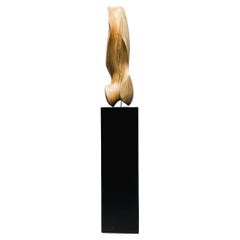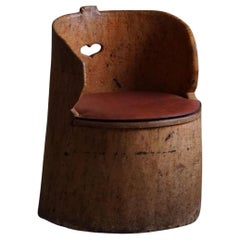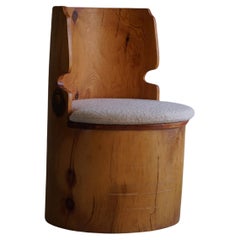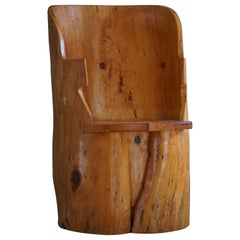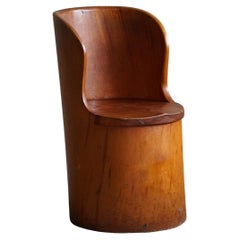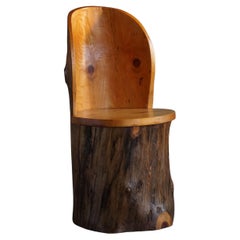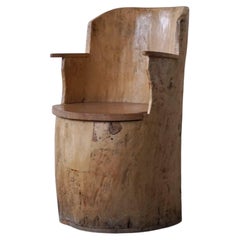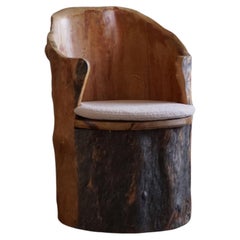Light Wabi Sabi
to
1
20
19
15
2
2
2
1
1
1
1
Sort By
Japanese Wall Light / Reproduction of Japanese Antique Lighting Wabi Sabi
By Japanese Studio
Located in Chōsei District Nagara, JP
This is our Japanese wall light.
It is a faithful reproduction of an antique light that was popular
Category
2010s Japanese Meiji Wall Lights and Sconces
Materials
Brass
H 7.09 in W 5.12 in D 9.85 in
Brutalist / Wabi Sabi Midcentury Hand Carved Light Wood Sculpture, 1970s
Located in AMSTERDAM, NL
An amorphous and free form sculpture by an unknown artist. Carved from one piece of natural wood with a sculptural and sensual shape. Powerful Brutalist sculpture with an interesting...
Category
Vintage 1970s Belgian Brutalist Abstract Sculptures
Materials
Wood
H 44.1 in W 10.63 in D 7.09 in
Hand Carved Rustic Stump Chair in Birch, Swedish Modern, Wabi Sabi, 1920s
Located in Odense, DK
an unknown Swedish cabinetmaker in the early 1900s. A beautiful wabi sabi piece for the modern
Category
Early 20th Century Swedish Brutalist Chairs
Materials
Wood, Birch
H 31.5 in W 22.45 in D 21.66 in
Sculptural Carved Wabi Sabi Brutalist Stump Chair in Solid Pine, Swedish, 1970s
Located in Odense, DK
functionality with beauty. Its focus is on simple lines and light spaces.
"Wabi-sabi is the view or thought of
Category
Mid-20th Century Swedish Mid-Century Modern Club Chairs
Materials
Pine, Bouclé
H 33.47 in W 22.84 in D 21.66 in
Stump Chair in Solid Birch by a Swedish Cabinetmaker, Wabi Sabi, 1950s
Located in Odense, DK
beauty. Its focus is on simple lines and light spaces.
"Wabi-sabi is the view or thought of finding
Category
Mid-20th Century Swedish Brutalist Armchairs
Materials
Birch
H 39.97 in W 24.41 in D 28.35 in
Hand Carved Primitive Stump Chair in Pine, Swedish Modern, Wabi Sabi, 1960s
Located in Odense, DK
simple lines and light spaces.
"Wabi-sabi is the view or thought of finding beauty in every aspect of
Category
Mid-20th Century Swedish Brutalist Chairs
Materials
Pine
H 31.11 in W 19.69 in D 19.69 in
Hand Carved Primitive Swedish Modern Stump Chair in Pine, Wabi Sabi, 1960s
Located in Odense, DK
simple lines and light spaces.
"Wabi-sabi is the view or thought of finding beauty in every aspect of
Category
Mid-20th Century Swedish Brutalist Armchairs
Materials
Pine
H 36.62 in W 18.51 in D 17.33 in
Wabi Sabi Stump Chair in Solid Birch, by a Swedish Cabinetmaker, Modern, 1950s
Located in Odense, DK
beauty. Its focus is on simple lines and light spaces.
"Wabi-sabi is the view or thought of finding
Category
Mid-20th Century Swedish Brutalist Armchairs
Materials
Birch
H 33.86 in W 21.66 in D 24.41 in
Hand-Carved Brutalist Stump Chair in Solid Pine, Wabi Sabi Style, Swedish, 1970s
Located in Odense, DK
the piece.
A charming wabi sabi object for the modern interior. Perfectly suited for an Antique
Category
Mid-20th Century Swedish Mid-Century Modern Club Chairs
Materials
Pine
H 32.29 in W 22.45 in D 21.66 in
Brutalist Stump Chair in Solid Pine & Bouclé, Swedish Mid Century Modern, 1970s
Located in Odense, DK
functionality with beauty. Its focus is on simple lines and light spaces.
"Wabi-sabi is the view or thought of
Category
Mid-20th Century Swedish Mid-Century Modern Club Chairs
Materials
Bouclé, Pine
H 34.26 in W 19.69 in D 19.69 in
Midcentury Light Brown Three Leg Wabi Sabi Tree Trunk Side / Coffee Table
Located in Berlin, DE
has got this Wabi Sabi look and the color is a light yellow brown tone.
A unique piece which is a
Category
Vintage 1970s French Mid-Century Modern Coffee and Cocktail Tables
Materials
Cherry
H 16.54 in Dm 22.45 in L 16.54 in
Sculptural Carved Wabi Sabi Brutalist Stump Chair in Solid Pine, Swedish, 1979
Located in Odense, DK
functionality with beauty. Its focus is on simple lines and light spaces.
"Wabi-sabi is the view or thought of
Category
Mid-20th Century Swedish Mid-Century Modern Club Chairs
Materials
Pine
H 36.62 in W 23.23 in D 22.84 in
Sweden Mid Century Modern, Sculptural Wabi Sabi Desk, 1940s
Located in Odense, DK
shape. The desk showcases a birch and a warm pine top, exuding a natural, wabi-sabi aesthetic. Its hand
Category
Mid-20th Century Swedish Scandinavian Modern Desks and Writing Tables
Materials
Birch, Pine
Primitive Sculptural Wabi Sabi Armchair in Solid Wood, Swedish Modern, 1950s
Located in Odense, DK
focus is on simple lines and light spaces.
"Wabi-sabi is the view or thought of finding beauty in every
Category
Mid-20th Century Swedish Brutalist Armchairs
Materials
Wood, Hardwood
H 35.44 in W 22.05 in D 19.69 in
Primitive Wooden Wabi Sabi Bench in Solid Pine, Swedish Carpenter, 1800s
Located in Odense, DK
beauty. Its focus is on simple lines and light spaces.
"Wabi-sabi is the view or thought of finding
Category
Antique Early 19th Century Scandinavian Brutalist Benches
Materials
Pine
H 16.54 in W 40.95 in D 14.38 in
Swedish Modern, Hand Crafted Primitive Bentwood Stump Chair, Wabi Sabi, 1940s
Located in Odense, DK
functionality with beauty. Its focus is on simple lines and light spaces.
"Wabi-sabi is the view or thought of
Category
Early 20th Century Swedish Folk Art Chairs
Materials
Wood, Birch
H 28.75 in W 24.02 in D 22.45 in
Sculptural Stump Chair in Solid Pine, Wabi Sabi, Swedish Mid Century, 1960s
Located in Odense, DK
functionality with beauty. Its focus is on simple lines and light spaces.
"Wabi-sabi is the view or thought of
Category
Mid-20th Century Swedish Mid-Century Modern Club Chairs
Materials
Pine, Lambskin, Sheepskin
H 35.04 in W 25.2 in D 25.6 in
Hand Carved Primitive Stump Chair in Pine, Swedish Modern, Wabi Sabi, 1950s
Located in Odense, DK
simple lines and light spaces.
"Wabi-sabi is the view or thought of finding beauty in every aspect of
Category
Mid-20th Century Swedish Brutalist Chairs
Materials
Wood, Pine
H 27.17 in W 17.72 in D 16.93 in
Hand Carved Primitive Stump Chair in Pine, Swedish Modern, Wabi Sabi, 1960s
Located in Odense, DK
simple lines and light spaces.
"Wabi-sabi is the view or thought of finding beauty in every aspect of
Category
Mid-20th Century Swedish Brutalist Chairs
Materials
Wood, Pine
H 30.71 in W 18.9 in D 17.72 in
Primitive Stump Chair in Pine, Hand Carved, Swedish Modern, Wabi Sabi, 1960s
Located in Odense, DK
simple lines and light spaces.
"Wabi-sabi is the view or thought of finding beauty in every aspect of
Category
Mid-20th Century Swedish Brutalist Chairs
Materials
Pine
H 29.93 in W 17.72 in D 18.12 in
Wabi Sabi Stump Chair in Solid Pine, by a Swedish Cabinetmaker, Modern - 1960s
Located in Odense, DK
functionality with beauty. Its focus is on simple lines and light spaces.
"Wabi-sabi is the view or thought
Category
Mid-20th Century Swedish Brutalist Armchairs
Materials
Pine
H 33.08 in W 22.05 in D 22.05 in
Get Updated with New Arrivals
Save "Light Wabi Sabi", and we’ll notify you when there are new listings in this category.
Light Wabi Sabi For Sale on 1stDibs
You are likely to find exactly the light wabi sabi you’re looking for on 1stDibs, as there is a broad range for sale. In our selection of items, you can find contemporary examples as well as an abstract version. If you’re looking for a light wabi sabi from a specific time period, our collection is diverse and broad-ranging, and you’ll find at least one that dates back to the 20th Century while another version may have been produced as recently as the 21st Century. If you’re looking to add a light wabi sabi to create new energy in an otherwise neutral space in your home, you can find a work on 1stDibs that features elements of gray, beige, brown, blue and more. There have been many interesting light wabi sabi examples over the years, but those made by Stefanie Schneider, Melisa Taylor Metzger, Michelle Y Williams, Natalia Wrobel and Chloe Hedden are often thought to be among the most thought-provoking. Artworks like these of any era or style can make for thoughtful decor in any space, but a selection from our variety of those made in paper, c print and polaroid can add an especially memorable touch.
How Much is a Light Wabi Sabi?
A light wabi sabi can differ in price owing to various characteristics — the average selling price for items in our inventory is $1,192, while the lowest priced sells for $50 and the highest can go for as much as $33,000.
Questions About Light Wabi Sabi
- 1stDibs ExpertMay 5, 2023The primary principle of Wabi-Sabi is to appreciate the imperfections found in nature. As a result, Wabi-Sabi emphasizes asymmetry, roughness, simplicity and the use of natural materials and finishes. On 1stDibs, shop a variety of pieces based on Wabi-Sabi principles.
- What is wabi-sabi pottery?1 Answer1stDibs ExpertApril 5, 2022Wabi-sabi pottery refers to earthenware vessels that embody the principles of a Japanese philosophy called wabi-sabi. Proponents of the idea believe that household objects should emphasize function over form, so that they satisfy needs but do not cause people to attach too much meaning to worldly possessions. There is also a focus on finding the beauty in imperfection and simplicity. On 1stDibs, find a collection of wabi-sabi pottery.
- What is wabi-sabi furniture?1 Answer1stDibs ExpertApril 5, 2022Wabi-sabi furniture refers to tables, seats and other furnishings that reflect a specific Japanese design philosophy. It involves creating minimalist furniture that has a focus on appreciating the imperfections found in nature. On 1stDibs, find a collection of wabi-sabi furniture.
- What is an example of wabi-sabi?2 Answers1stDibs ExpertApril 5, 2022Wabi-sabi is the practice of finding the beauty in imperfections. Examples include flowers growing through cracks in the ground, or a broken ceramic bowl made whole again with its imperfections showing through. You’ll find a variety of wabi-sabi pieces from some of the world’s top sellers on 1stDibs.1stDibs ExpertApril 5, 2022One important aspect of wabi-sabi is the beauty in imperfect things, so a good example of wabi-sabi would be asymmetrical or even crude vessels and furniture. On 1stDibs, you’ll find a collection of wabi-sabi furniture and other objects from some of the world’s top sellers.
- Is Wabi-sabi a design style?1 Answer1stDibs ExpertMay 5, 2023Wabi-sabi is technically not a design style, but it has influenced design. The term Wabi-sabi refers to a philosophy that emphasizes accepting imperfection and celebrating the impermanent beauty of nature. This concept has inspired many interior design trends, such as using organic and sustainable materials, selecting upcycled and repurposed pieces and integrating furniture and decorative objects that are unfinished, unpolished and unglazed. Shop a collection of pieces inspired by Wabi-sabi on 1stDibs.

